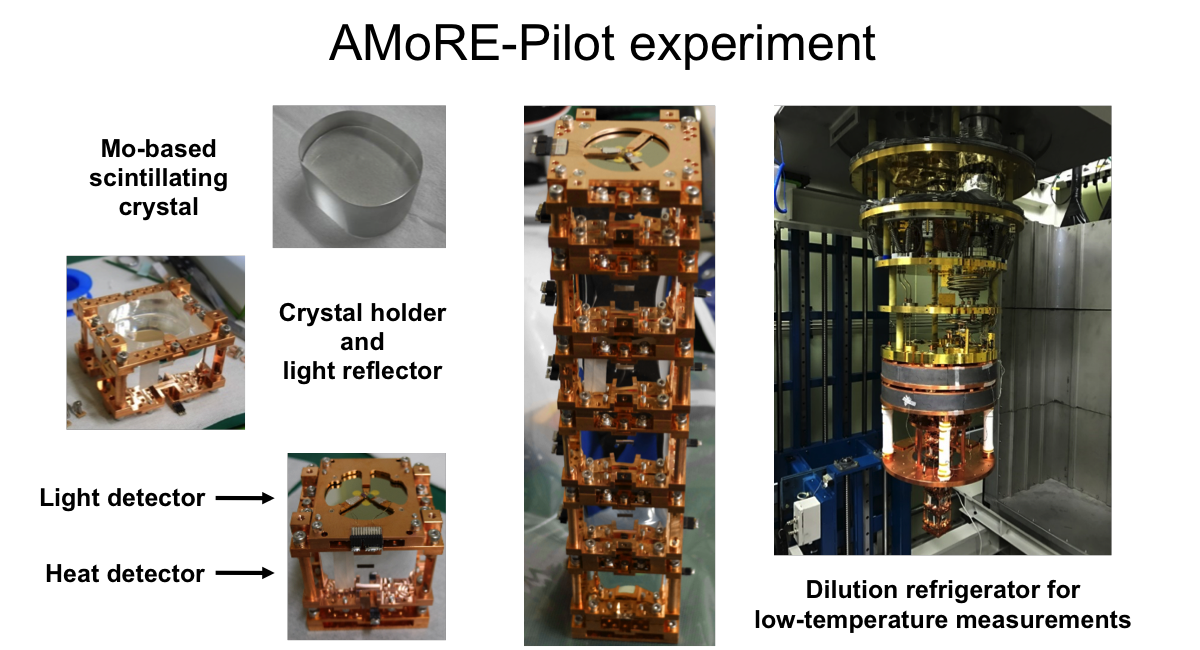
AMoRE-Pilot, the pilot phase of the AMoRE project, is an experiment that has been running in the 700-m-deep Yangyang underground Laboratory (Y2L) since summer 2015 using 100Mo-enriched, 48Ca-depleted 40Ca100MoO4 scintillating crystals. The experiment started and ran with five crystals, with a total mass of about 1.6 kg, until a sixth calcium molybdate crystal was installed in spring 2017, resulting in a total crystal mass of about 1.9 kg. Each crystal is equipped with a heat (phonon) detector and a light (photon) detector for a simultaneous measurement. When a particle interacts with the crystal, the produced heat and light are measured using metallic magnetic calorimeters (MMCs), which are highly sensitive temperature sensors operating at millikelvin temperatures. The MMC signals are then read via a superconducting quantum interference device (SQUID). MMCs are useful in particle physics experiments searching for rare events as they offer a fast response, high energy and timing resolutions, and good particle discrimination. A dilution refrigerator allows us to reach operating temperatures as low as 8 mK. After several runs and subsequent detector setup upgrades, the first long run of AMoRE-Pilot is currently underway.

The experimental site is located at Yangyang underground laboratory (Y2L), situated at Yangyang pumped storage power plant, with ~700 m of rock overburden. In addition to the COSINE-100 experiments, Y2L is home to the AMoRE and KIMS-CsI experiments.
Purification for the AMoRE-II
The purification of molybdenum oxide is one of the important tasks of the Advanced Mo based Rare process Experiment in searching for the neutrinoless double beta (0νββ) decay of 100Mo. Purified MoO3 powder is used as initial material for further growth of radiopure monocrystals. As purification technique, double sublimation, co-precipitation with calcium chloride carrier, and precipitation of polyammonium molybdate from acidic media were used.
Concentrations of impurities like Sr, Ba, Pb, Th and U were measured by ICP-MS and radioactive isotopes were checked by a HPGe detector at the YangYang underground Laboratory in Korea.
Successful double sublimation provided reduction of radioactive contamination on the level above 80 for 226Ra and 120 times for 228Ac, concentrations of Ba and Sr were reduced 80 times as well. The yield efficiency after sublimation of 1.2 kg of MoO3 powder was larger than 99%. Co-precipitation with calcium molybdate collector allows to remove more than 95% of Ba, Pb and U contaminations.
The combination of co-precipitation and precipitation allowed to achieve total decontamination factor for Sr, Ba, Pb and U on the level of several hundreds, concentration of thorium was reduced below detection limit of the ICP-MS measurement. Taking into account 3% losses of Mo with collector for co-precipitation, the final yield efficiency after wet chemistry purification technique is around 95%.
Our research for advanced purification technique is ongoing and combination of double sublimation with wet chemical purification looks promising and will be applied in order to improve the presented results.